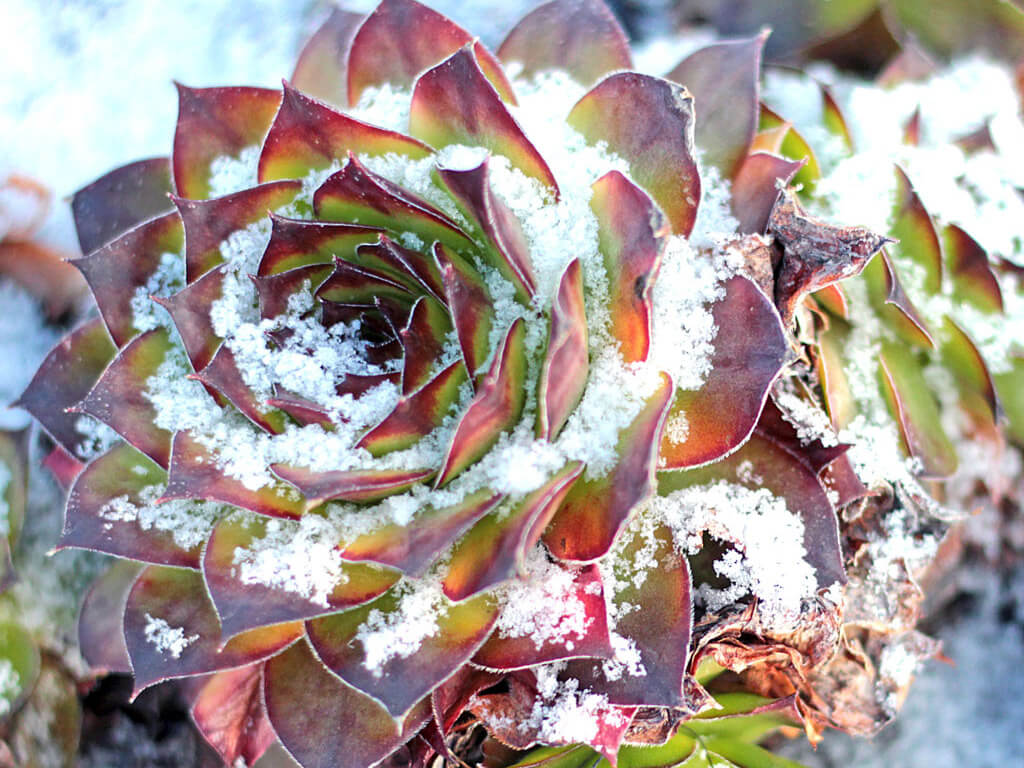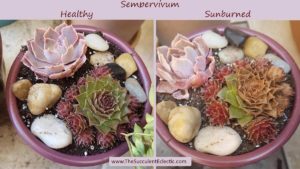It’s always exciting when you bring a new succulent home! Whether you picked it up from the local nursery or it was delivered from a top-notch succulent vendor, you can’t wait to put it in its new spot, right? After all, outdoor succulents belong outdoors. Or maybe winter is finally over, and you want to put your full sun succulents right out in the garden.
Wait!
I know you’re eager, but first, let’s look at the importance of properly acclimating your outdoor succulents to their new home. Succulents need time to respond to the change in their growing conditions before they will be safe growing outdoors in direct sun. Before you shrug off this advice, know this: Full sun succulents will sunburn and winter-hardy succulents do freeze when they are not properly acclimated to outdoor growing conditions. You certainly can luck into getting the conditions for outdoors succulents right. But let’s take a little time being safe, rather than spend a lot being sorry.
Why full sun succulents burn and cold-hardy succulents freeze!
In this Post We'll Cover:
{Please note, some links in this post may be affiliate links to sites that pay me a small commission if you click on the link and make a purchase. This commission is at absolutely no cost to you. I only recommend products and companies that I have worked with and truly love! ~Kat}
Acclimating to a Changing Environment

Every time I try to explain the importance of acclimating outdoor succulents, I find myself talking about foxes… The pictures above both depict an Artic fox, but they look like entirely different animals, don’t they? As temps cool in fall and winter approaches, Arctic foxes develop a very thick, warm, white winter coat. It serves to keep them warm in below freezing temps and the white color enables them to hide from both predators and prey. But when winter turns to spring, the fox sheds its thick, white coat and sports sleek, short brown fur instead. This way, he doesn’t overheat and he can still be camouflaged. He is perfectly adapted to his environment even as it changes so dramatically. Nature is a beautiful thing!
But think what would happen to this poor fox if he had to face the frigid cold of winter while in his summer coat? He’d surely die! And if he stepped into summer, wearing his winter coat, he’d quickly overheat, and his dinner would spot him coming before he could pounce! What makes the fox so admirably adapted to his changing environment is that he changes with it. Although the changes are dramatic, they happen gradually, over time, so his body has time to make its physiological changes along with the rising or falling temperatures. He lives outside, in his changing environment, so he changes in response to the changes of his natural world.
We have taken succulents out of the natural world, to overwinter them indoors, protecting them from freezing. We bring them out of the deserts, mountains, rainforests and highlands where they grow natively to bring them into our gardens. Commercial growers provide shelter to bring out the best coloring in their outdoor succulents without the risk of sunburn from too much light. When we shelter our plants from the changing environment, they don’t have a chance to acclimate and develop their natural defenses on their own. So, we need to introduce them to their new environment more gradually, so they can acclimate.
Outdoor Succulents Acclimate to a Changing Environment

Our succulents protect themselves from a changing environment in ways similar to the fox. They develop protective pigments that resist succulent sunburn in the heat of summer. Specialized proteins called cryoprotectantsCryoprotectants (Kri-oh-pro-TECK-tants) are specialized prot... More enable winter hardy succulents to survive the cold. This is why succulents are at their most colorful outdoors in summer and winter. But these protective adaptations take time to develop. And the plant won’t “know” to develop these protections if it is kept in an artificially protected environment, like our homes or a commercial grower’s facility. Outdoor succulents experience gradually cooling temperatures and shortening days that trigger the development of the cryoprotectants that power its winter-hardiness. Conversely, gradually rising temps and lengthening days stimulate the development of the protective pigments that combat sunburn. It is the ability to develop these protections that make a plant a full sun succulent or a winter hardy one.
This gradual process of acclimation happens in the natural world. If you take a cold-hardy Sempervivum grown in your home from August through December, then set it straight out into a snowstorm, the plant will die. Like the fox in his summer coat above, this Sempervivum would not have had the chance to build up the natural protections that enable it to survive winter. Had it remained outdoors the entire time, it would have shrugged off the snow and ice with ease. Likewise, a full sun succulent variety that is kept indoors or grown under shade can sunburn if it is not given time to fully acclimate before it is left in hot, blazing sunshine all day long.
Acclimating Winter-Hardy Outdoor Succulents

I recommend planting winter-hardy outdoor succulents like Sempervivum and cold-hardy Sedum at least a full six weeks before your area’s first ground freeze. Planting hardy succulents well before freezing gives them time to acclimate to cooling temperatures by developing the cryoprotectants that will protect them from damage.
If you discover some of the succulents you are overwintering indoors are actually cold hardy varieties, and winter temps below freezing have already set in, wait until spring to set them outdoors. It is difficult to replicate slowly cooling temperatures well enough to stimulate a succulent’s adaptations to the cold.
Acclimating Outdoors Succulents to Full Sun

Remember that what makes a full sun succulent able to handle full sun is its ability to develop sufficient protective pigments to prevent sunburn. But if that full sun succulent has been growing in your home, it will not have developed those pigments. Set it directly in full sun and it will burn. Even if you grow it under grow lights, and it develops good coloring, I still recommend that you acclimate the plant gradually to full sun. Most grow lights for succulents do not emit UV light, and you cannot see it. But it is the ultraviolet spectrum of sunlight, together with the intensity of the light that causes succulents to sunburn. Growing indoors, a plant has no need to protect against UV rays. If you shove it outdoors into full sun without preparation, it will burn. This is a greater danger in summer than early spring, but the risk is real at any time of the year.
But what about outdoor succulents you pick up at the nursery? They were growing outside and should be fine to go straight out into full sun, right? Not so fast. Before taking your succulent to the register, look up. You will likely see a protective screen of shade cloth filtering out much of the UV rays of the sun.
Shade cloth is awesome stuff! It allows enough light to penetrate to keep your succulents healthy., compact and colorful, but it cuts out a lot of UV light and heat, as well. (When shopping for shade cloth, don’t get confused by the colors! Succulents do best with 40% to 70% shade cloth) Commercial growers and nurseries use shade cloth because it allows enough sunshine through to keep succulents healthy, compact and colorful, but it prevents sunburn! Win-win. But, because it filters out so much of UV rays, shade cloth leaves your full sun succulent vulnerable to sunburn if you set it straight out into full sun.
How to Acclimate Succulents to Sunlight Outdoors

Now that you know how to acclimate your outdoor succulents to sunshine outdoors, how should you do it? First, remember that your sunniest window indoors or your brightest grow light does not expose your succulents to UV light, which is part of the non-visible spectrum of sunlight that burns your plants. They do need to be acclimated.
Start by placing your succulents outside where they can receive bright, indirect sunlight. If your only options are full, direct sun or shade. try rigging something temporary to give you a more filtered light. Shade cloth is great for this. If you have shade cloth, set it up in a full sun location, and move all your outdoor succulents to the filtered sun it provides. Let the plants remain in the filtered or indirect light for 3 days, watching to see how your succulents respond to the light. If they appear to be stressed by the amount of light, either give them a bit more shade, or let them acclimate to the filtered light for a longer period of time. If they are doing well, after 3 days, move those you want in more sun out into direct sun for half an hour. Then, move it back under protection. Continue to increase the sun exposure by 30 minutes every couple of days until it is able to remain in your preferred location.
Yes, acclimating your succulents to full sun this way is a bit of a hassle. But a little extra care now prevents serious damage or death for your beloved succulents. If you want to skip this process, shade cloth is the way to go. It allows your succulents to grow lush and healthy, remain compact and display their best colors.

When we take plants or animals out of their natural environment to bring them into our homes and gardens, we take on the responsibility of helping them to acclimate to their new conditions. A little extra care now, prevents scarring and potential death for your outdoors succulents. Before setting full sun succulents out into the direct rays of the sun, be sure they have a chance to prepare their natural defenses against sunburn. They will repay your time and attention with beauty and lush growth!
Because life uis just better with succulents!
P.S. For my complete guide to succulent care, get my FREE e-course, 7 Steps to Succulent Success, by subscribing! Thanks so much!
P.P.S. Why not join my Facebook Group for succulent lovers? We talk about succulent care, propagation, succulent identification, and design. It’s a warm and welcoming group that would love to meet you!




